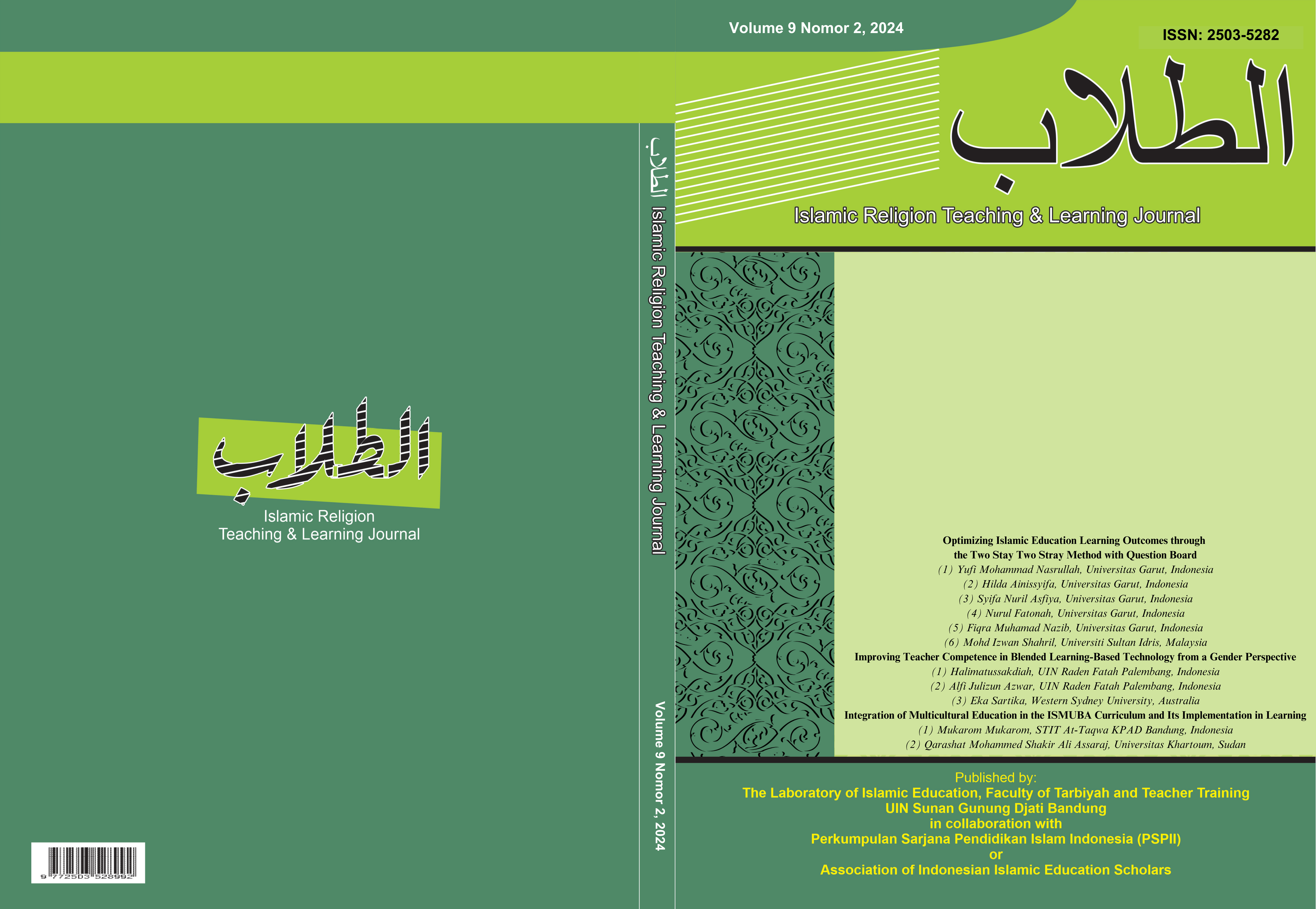Improving Teacher Competence in Blended Learning-Based Technology from a Gender Perspective
DOI:
https://doi.org/10.15575/ath.v9i2.39698Keywords:
Blended Learning, Gender Perspective, Teacher Competence, Technology Integration in EducationAbstract
This research discusses efforts to increase teacher competency in blended learning-based technology through a gender approach. Blended learning, which combines online and face-to-face learning methods, has the potential to increase interaction and learning accessibility, but requires adequate technological skills from teachers. By considering a gender perspective, this research explores the differences and gaps that may arise between male and female teachers in adopting blended learning technology. Data was collected through a survey of a number of teachers from various school levels who had access to blended learning training. The research results show that there are disparities in the use of technology, where gender, age and experience factors influence teacher competence in implementing learning technology. This research recommends gender-based training that supports all teachers in developing their technology skills, to create more inclusive and effective learning environments. Thus, increasing this competency not only supports teacher career development, but also improves student learning outcomes through the use of more adaptive and responsive technology. Penelitian ini membahas upaya peningkatan kompetensi guru dalam teknologi berbasis pembelajaran campuran (blended learning) melalui pendekatan gender. Blended learning yang menggabungkan metode pembelajaran daring dan tatap muka memiliki potensi untuk meningkatkan interaksi dan aksesibilitas pembelajaran, namun memerlukan keterampilan teknologi yang memadai dari guru. Dengan mempertimbangkan perspektif gender, penelitian ini mengeksplorasi perbedaan dan kesenjangan yang mungkin muncul antara guru pria dan wanita dalam mengadopsi teknologi blended learning. Data dikumpulkan melalui survei terhadap sejumlah guru dari berbagai tingkatan sekolah yang memiliki akses terhadap pelatihan blended learning. Hasil penelitian menunjukkan adanya disparitas dalam penggunaan teknologi, di mana faktor gender, usia, dan pengalaman mempengaruhi kompetensi guru dalam penerapan teknologi pembelajaran. Penelitian ini merekomendasikan pelatihan berbasis gender yang mendukung seluruh guru dalam mengembangkan keterampilan teknologi mereka, guna menciptakan lingkungan belajar yang lebih inklusif dan efektif. Dengan demikian, peningkatan kompetensi ini tidak hanya mendukung perkembangan karir guru, tetapi juga meningkatkan hasil belajar siswa melalui penggunaan teknologi yang lebih adaptif dan responsif.References
Al-Awlaqi, M. A., Taqi, A. M., Saad, N. H. B. M., & Al-Samhi, N. (2022). Digital support, teacher support, and blended learning performance: Investigating the moderating effect of gender using multigroup PLS-SEM analysis. International Conference on Emerging Technologies and Intelligent Systems, 392–401. https://doi.org/https://doi.org/10.1007/978-3-031-20429-6_36
Al-samarraie, H., & Saeed, N. (2018). A Systematic Review of Cloud Computing Tools for Collaborative Learning: Opportunities and Challenges to the Blended-Learning Environment. Computers and Education, 124, 77–91. https://doi.org/https://doi.org/10.1016/j.compedu.2018.05.016
Boelens, R., Voet, M., & Wever, B. De. (2018). The design of blended learning in response to student diversity in higher education: Instructors’ views and use of differentiated instruction in blended learning. Computers & Education, 120, 197–212. https://doi.org/https://doi.org/10.1016/j.compedu.2018.02.009
Bygstad, B., Øvrelid, E., Ludvigsen, S., & Dæhlen, M. (2022). From dual digitalization to digital learning space: Exploring the digital transformation of higher education. Computers & Education, 182, 104463. https://doi.org/https://doi.org/10.1016/j.compedu.2022.104463
Cagang, A. J., Sinang, A., Butlig, S. P. Q., & Española, E. (2023). Gender and Development Awareness Towards Gender-sensitive Pedagogical Practices of Pre-service Teachers: Basis for a University GAD Program. Asian Journal of Education and Social Studies, 49(3), 266–280. https://doi.org/https://doi.org/10.9734/ajess/2023/v49i31153
Crittenden, W. F., Biel, I. K., & III, W. A. L. (2019). Embracing Digitalization: Student Learning and New Technologies. Journal of Marketing Education, 41(1), 5–14. https://doi.org/https://doi.org/10.1177/0273475318820895
Foulger, T. S., Graziano, K. J., Schmidt-Crawford, D. A., & Slykhuis, D. A. (2017). Teacher Educator Technology Competencies. Journal of Technology and Teacher Education, 36.
Graham, C. R., Woodfield, W., & Harrison, J. B. (2013). A framework for institutional adoption and implementation of blended learning in higher education. The Internet and Higher Education, 18, 4–14. https://doi.org/https://doi.org/10.1016/j.iheduc.2012.09.003
Gusmawan, Dendy Maulana, and T. H. (2022). Analysis of Numerical Aspects in School Education Report. Jurnal Analisa, 8(2), 107–116. https://doi.org/https://doi.org/10.15575/ja.v8i2.19550
Hilbert, M. (2011). Digital gender divide or technologically empowered women in developing countries? A typical case of lies, damned lies, and statistics. Women’s Studies International Forum, 34(6), 479–489. https://doi.org/http://dx.doi.org/10.1016/j.wsif.2011.07.001
Hrastinski, S. (2019). What do we mean by blended learning? TechTrends, 63(5), 564–569. https://doi.org/https://doi.org/10.1007/s11528-019-00375-5
Jr, B. A., Kamaludin, A., Romli, A., Raffei, A. F. M., Phon, D. N. A. E., Abdullah, A., Ming, G. L., Shukor, N. A., Nordin, M. S., & Baba, S. (2019). Exploring the role of blended learning for teaching and learning effectiveness in institutions of higher learning: An empirical investigation. Educ Inf Technol, 24, 3433–3466. https://doi.org/https://doi.org/10.1007/s10639-019-09941-z
Mariscal, J., Mayne, G., Aneja, U., & Sorgner, A. (2019). Bridging the Gender Digital Gap. Economics, 13(9), 1–12. https://doi.org/https://doi.org/10.5018/economics-ejournal.ja.2019-9
Meral, M., Colak, E., & Zereyak, E. (2012). The relationship between self-efficacy and academic performance. Procedia - Social and Behavioral Science, 46, 1143 – 1146. https://doi.org/10.1016/j.sbspro.2012.05.264
Ntim, S., Kwarteng, Opoku-Manu, M., & Addai-Amoah, A. (2021). Post COVID-19 and the Potential of Blended Learning in Higher Institutions: Exploring Students and Lecturers Perspectives on Learning Outcomes in Blended Learning. European Journal of Education and Pedagogy, 2(6), 49–59. https://doi.org/https://doi.org/10.24018/ejedu.2021.2.6.162
Nyanchoka, L., Tudur-Smith, C., Thu, V. N., Iversen, V., Tricco, A. C., & Porcher, R. (2019). This research approach prioritizes a quantitative approach through surveys to obtain. Journal of Clinical Epidemiology, 109, 99–110. https://doi.org/https://doi.org/10.1016/j.jclinepi.2019.01.005
Orser, B., Riding, A., & Li, Y. (2019). Technology adoption and gender-inclusive entrepreneurship education and training. International Journal of Gender and Entrepreneurship, 11(3), 273–298.
Parsons, S. A., Vaughn, M., Scales, R. Q., Gallagher, M. A., Parsons, A. W., Davis, S. G., Pierczynski, M., & Allen, M. (2018). Teachers’ Instructional Adaptations: A Research Synthesis. Review of Educational Research, 88(2), 205–242. https://doi.org/https://doi.org/10.3102/0034654317743198
Paudel, P. (2021). Online Education: Benefits, Challenges and Strategies During and After COVID-19 in Higher Education. International Journal on Studies in Education (IJonSE), 3(2), 70–85. https://doi.org/https://doi.org/10.46328/ijonse.32
Pulham, E., & Graham, harles R. (2018). Comparing K-12 online and blended teaching competencies: a literature review. Distance Education, 39(3), 411–432. https://doi.org/https://doi.org/10.1080/01587919.2018.1476840
Rarieya, J., WWango, N., Oluga, M., & Abunga, O. (2024). Accelerating Primary Education Tutors’ Acquisition of Gender-Responsive Pedagogies. European Journal of Education and Pedagogy, 5(4), 47. https://doi.org/10.24018/ejedu.2024.5.4.849
Rashid, A. T. (2016). Digital Inclusion and Social Inequality: Gender Differences in ICT Access and Use in Five Developing Countries. Gender, Technology and Development, 20, 306–332. https://doi.org/https://doi.org/10.1177/0971852416660651
Rasmitadila, R., Aliyyah, R. R., Rachmadtullah, R., Samsudin, A., Syaodih, E., Nurtanto, M., & Tambunan, A. R. S. (2020). The perceptions of primary school teachers of online learning during the COVID-19 pandemic period. Journal of Ethnic and Cultural Studies, 7(2), 90–109. https://doi.org/http://dx.doi.org/10.29333/ejecs/38
Rieley, J. B. (2020). Corona Virus and its impact on higher education. Research Gate, 2(3).
Roziqin, A., Mas’udi, S. Y. F., & Sihidi, I. T. (2021). An analysis of Indonesian government policies against COVID-19. Public Administration and Policy: An Asia-Pacific Journal, 24(1), 92–107. https://doi.org/https://doi.org/10.1108/PAP-08-2020-0039
Salam, M., Iskandar, D. N. A., Ibrahim, D. H. A., & Farooq, M. S. (2019). Technology integration in service-learning pedagogy: A holistic framework. Telematics and Informatics, 38, 257–273. https://doi.org/https://doi.org/10.1016/j.tele.2019.02.002
Shi1, J., Song, Y., Li, L., Chen, T., & Huang, B. (2023). Research on the Teaching Quality Evaluation System and Improvement Path of Ideological and Political for Online and Offline Blended Learning in Universities. International Journal of New Developments in Education, 5(24), 64–73. https://doi.org/10.25236/IJNDE.2023.052410
Sorgner, A., Bode, E., Krieger-Boden, C., Aneja, U., Coleman, S., Mishra, V., & Robb, A. M. (2017). The effects of digitalization on gender equaliy in the G20 economies: Women20 study. Kiel Institute for the World Economy (IfW), Kiel.
Spangenberg, E. D., & Freitas, G. De. (2019). Mathematics teachers’ levels of technological pedagogical content knowledge and information and communication technology integration barriers. Pythagoras, 40(1), 1–13. https://doi.org/10.4102/pythagoras.v40i1.431
Szymkowiak, A., Melović, B., C, M. D., Jeganathan, K., & Kundi, G. S. (2021). As a result, technology now plays a critical role in education, and both teachers and students need to adapt to its use. Technology in Society, 65, 101565. https://doi.org/https://doi.org/10.1016/j.techsoc.2021.101565
Unger, S., & Meiran, W. R. (2020). Student Attitudes towards Online Education during the COVID-19 Viral Outbreak of 2020: Distance Learning in a Time of Social Distance. International Journal of Technology in Education and Science, 4(4), 256–266.
Unterhalter, E. (2017). Global: What is Wrong with Global Inequality in Higher Education. Understanding Global Higher Education, 205, 1–7. https://doi.org/https://doi.org/10.1007/978-94-6351-044-8_1
Wadhwa, B., Grover, P., Dasgupta, S., & Uppal, A. (2022). Role of power distance phenomena in blended learning in higher education post-Covid-19. Cardiometry, 22, 343–350. https://doi.org/10.18137/cardiometry.2022.22.343350
Downloads
Published
How to Cite
Issue
Section
License
Authors who publish with this journal agree to the following terms:
- Authors retain copyright and grant the journal right of first publication with the work simultaneously licensed under a Creative Commons Attribution-ShareAlike License that allows others to share the work with an acknowledgement of the work's authorship and initial publication in this journal.
- Authors are able to enter into separate, additional contractual arrangements for the non-exclusive distribution of the journal's published version of the work (e.g., post it to an institutional repository or publish it in a book), with an acknowledgement of its initial publication in this journal.
- Authors are permitted and encouraged to post their work online (e.g., in institutional repositories or on their website) prior to and during the submission process, as it can lead to productive exchanges, as well as earlier and greater citation of published work (See The Effect of Open Access).




